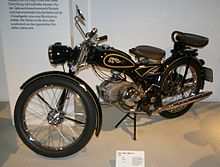Riedel Imme
Imme is the trade name of the German light motorcycle type R 100 , which was developed by Norbert Riedel from 1947 . The motorcycle, which was futuristic at the time, had a number of unusual design features. The name is derived from the location of the Immenstadt production facility in the Allgäu.
history
The engineer Norbert Riedel worked as a designer at Ardie , Victoria and Triumph in Nuremberg in the 1930s . He won the competition for the construction of a starter motor for the aircraft turbine of the Messerschmitt Me 262 . After the war he developed a motorcycle and set up a production facility in Immenstadt. Series production of the Riedel R 100 began in June 1949 . The tightly calculated price of 775 marks and high warranty costs led to financial difficulties. After a comparison in autumn 1950, the development work for the Roller Till was stopped.
For these reasons , the two-cylinder model developed by Riedel, the R 150 , could no longer be brought onto the market. In October 1951, Riedel Motoren AG filed for bankruptcy as a result of a withdrawn bank loan.
Always R 100
Riedel initially only used a single pipe diameter for his motorcycle, later some pipes were made larger. From this he manufactured the complete frame including the steering head and swing arm bearings, the one-armed parallelogram fork - referred to in the factory documents as the "half parallelogram fork" - and the one-armed rear swing arm. This swing arm was designed as a cantilever and drive train swing arm and at the same time an exhaust pipe. A horizontal central spring supported on the frame tube served as suspension. The two wheels were identical and interchangeable. The Imme R 100 , the official type designation, developed 3.3 kW (4.5 HP) at 5800 rpm from a displacement of 99 cm³. The consumption of the 57 kg heavy machine, which was originally only available painted in “oxide red”, was 2.3 l per 100 km.
One of the special features of the Imme was the twist grip shifting of the three-speed transmission, in which the position for the first gear was in the middle and at the same time was the neutral position; because first gear was also engaged in neutral, but the clutch lever was operated permanently with the help of a wire clip. The gearbox was a ball draw key gear . Another special feature of the engine - the one-sided crankshaft bearing - was abandoned with the appearance of the "R 100 / D" model. The flat piston two-stroke engine was designed with a 52 mm bore and 47 mm stroke slightly under-square (stroke ratio 0.904); the method of operation was specified as a steep-flow flush with two windows. The drum brakes were designed as inner band brakes .
Riedel's attention to detail went so far that even the battery was custom-made: the housing was triangular and the color was oxide red.
Around 12,000 vehicles had been built by the end of production in 1951. To market the bankruptcy estate, the last operations manager, the mechanical engineer Fritz Philipps, founded ZMG Zweirad-Motoren u. Gear established . This took over the spare parts supply with customer service and further developments. This is how the 125 cc engine was created, 44 of which were delivered. The two-cylinder engine of the "R 150" was enlarged to 175 cm³ displacement (8.5 hp) with a modified gearbox design and delivered to around 30 customers. The 100 Imme chassis was modified so that the Imme two-cylinder engines could be installed there. The further development also provided for a 200 engine, three of which were produced. These further developments were often equipped with a modified exhaust system with Adler or Sachs rear silencers. This enabled an increase in performance and a significantly better thermal behavior of the motors. From 1956 onwards, due to a lack of demand, Fritz Philipps concentrated more and more on gear production, which he had headed as operator for almost 10 years at the NSU plants in Mülhausen (Alsace) and Neuenstein during and after the war.
Remarks)
- ↑ The scooter can be seen in a Heimatfilm with Walter Müller .
Web links
- The personal article on Norbert Riedel contains photos of the Riedel starter.
- Sassy bee. ( Memento from January 2, 2013 in the Internet Archive ) In: Motorcycle . 22, 2003 (PDF file; 342 kB).
- Website of the Imme-Freundeskreis
Individual evidence
- ↑ German motorcycle engines with 150 cm³ . In: Automobiltechnische Zeitschrift . 2/1952, pp. 35-38.

